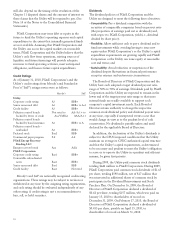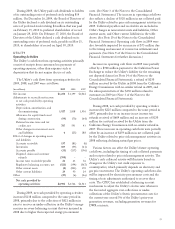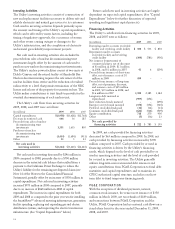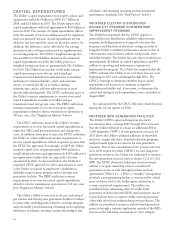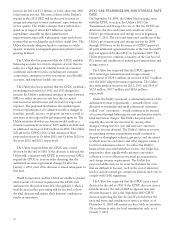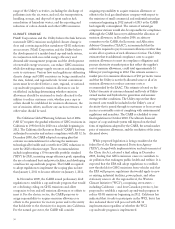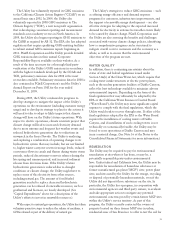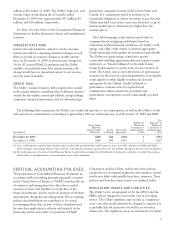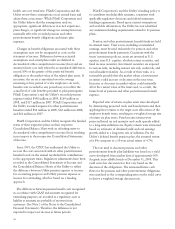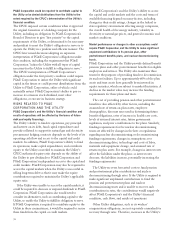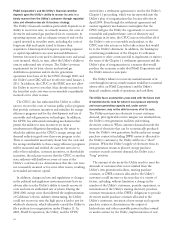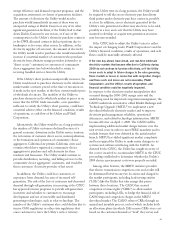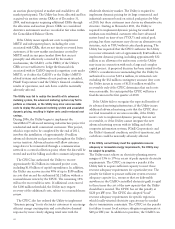PG&E 2009 Annual Report Download - page 36
Download and view the complete annual report
Please find page 36 of the 2009 PG&E annual report below. You can navigate through the pages in the report by either clicking on the pages listed below, or by using the keyword search tool below to find specific information within the annual report.residues, and depending on the results of such tests, to take
appropriate remedial action. Until the Utility’s
investigation of these MGP sites in San Francisco is
complete, the extent of the Utility’s obligation to remediate
is established, and any appropriate remedial actions are
determined, the Utility is unable to determine the amounts
it may spend in the future to remediate these sites and no
amounts have been accrued for these sites (other than
investigative costs). Although it is reasonably possible that
the Utility will incur losses in the future related to these
sites, the Utility is unable to reasonably estimate the
amount of such loss. The Utility expects that it will recover
90% of the costs to remediate MGP sites under a
ratemaking mechanism established by the CPUC. The
Utility will seek to recover remaining costs through
insurance. (See “Risk Factors” and “Critical Accounting
Policies” below, as well as Note 16 of the Notes to the
Consolidated Financial Statements, for a discussion of
estimated environmental remediation liabilities.)
LEGAL MATTERS
PG&E Corporation and the Utility are subject to various
laws and regulations and, in the normal course of business,
PG&E Corporation and the Utility are named as parties in
a number of claims and lawsuits. (See Note 16 of the Notes
to the Consolidated Financial Statements for a discussion
of the accrued liability for legal matters.)
RISK MANAGEMENT ACTIVITIES
The Utility and PG&E Corporation, mainly through its
ownership of the Utility, are exposed to market risk, which
is the risk that changes in market conditions will adversely
affect net income or cash flows. PG&E Corporation and
the Utility face market risk associated with their operations;
their financing arrangements; the marketplace for
electricity, natural gas, electricity transmission, natural gas
transportation, and storage; other goods and services; and
other aspects of their businesses. PG&E Corporation and
the Utility categorize market risks as “price risk” and
“interest rate risk.” The Utility is also exposed to “credit
risk,” the risk that counterparties fail to perform their
contractual obligations.
The Utility actively manages market risks through risk
management programs designed to support business
objectives, discourage unauthorized risk-taking, reduce
commodity cost volatility, and manage cash flows. The
Utility uses derivative instruments only for non-trading
purposes (i.e., risk mitigation) and not for speculative
purposes. The Utility’s risk management activities include
the use of energy and financial instruments such as forward
contracts, futures, swaps, options, and other instruments
and agreements, most of which are accounted for as
derivative instruments. Some contracts are accounted for as
leases.
PRICE RISK
The Utility is exposed to commodity price risk as a result
of its electricity procurement activities, including the
procurement of natural gas and nuclear fuel necessary for
electricity generation and natural gas procurement for core
customers. As long as the Utility can conclude that it is
probable that its reasonably incurred wholesale electricity
procurement costs and natural gas costs are recoverable,
fluctuations in electricity and natural gas prices will not
affect earnings but may impact cash flows. The Utility’s
natural gas transportation and storage costs for core
customers are also fully recoverable through a ratemaking
mechanism.
The Utility’s natural gas transportation and storage costs
for non-core customers may not be fully recoverable. The
Utility is subject to price and volumetric risk for the
portion of intrastate natural gas transportation and storage
capacity that has not been sold under long-term contracts
providing for the recovery of all fixed costs through the
collection of fixed reservation charges. The Utility sells
most of its capacity based on the volume of gas that the
Utility’s customers actually ship, which exposes the Utility
to volumetric risk.
The Utility uses value-at-risk to measure the
shareholders’ exposure to price and volumetric risks
resulting from variability in the price of, and demand for,
natural gas transportation and storage services that could
impact revenues due to changes in market prices and
customer demand. Value-at-risk measures this exposure
over a rolling 12-month forward period and assumes that
the contract positions are held through expiration. This
calculation is based on a 95% confidence level, which
means that there is a 5% probability that the impact to
revenues on a pre-tax basis, over the rolling 12-month
forward period, will be at least as large as the reported
value-at-risk. Value-at-risk uses market data to quantify the
Utility’s price exposure. When market data is not available,
the Utility uses historical data or market proxies to
extrapolate the required market data. Value-at-risk as a
measure of portfolio risk has several limitations, including,
but not limited to, inadequate indication of the exposure
to extreme price movements and the use of historical data
or market proxies that may not adequately capture
portfolio risk.
The Utility’s value-at-risk calculated under the
methodology described above was approximately $12
32


